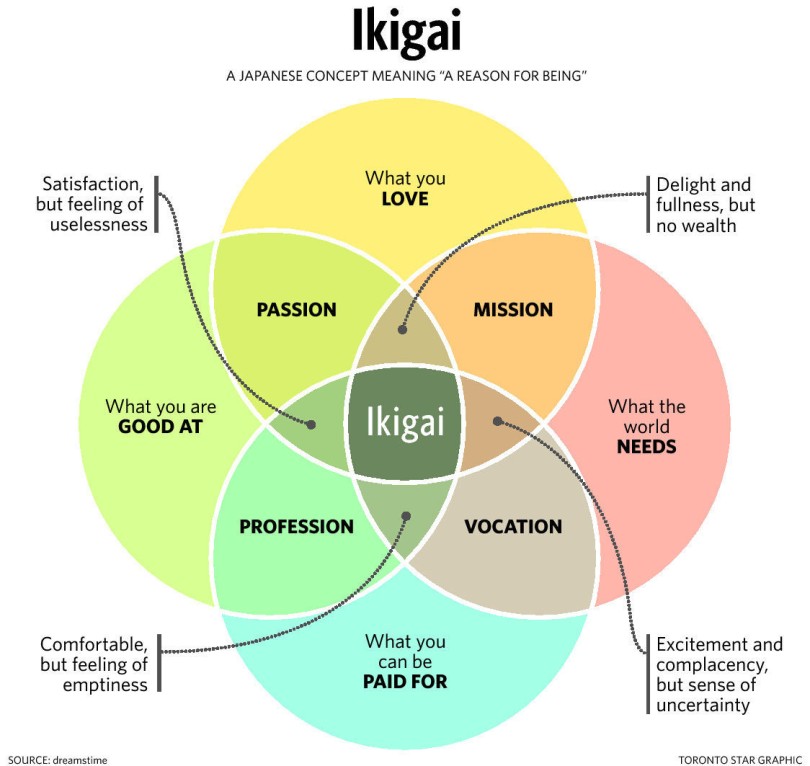The Origin of the Venn Diagram Symbolizing Ikigai and its Meaning is the topic of today’s post.
In the last post, I ended my article as the following.
By the way, where did this concept of ikigai described in the diagram come from? I had never heard of it, and neither have most Japanese. You can ask your Japanese friend to check if you like.

I don’t think it said anything about it in the book Ikigai: The Japanese Secret to a Long and Happy Life, or maybe I missed it.
I have read over a half of The Little Book of Ikigai: The Japanese Guide to Finding Your Purpose in Life, and yet, I haven’t come across a sentence explaining the origin of the diagram so far. Again I might have missed it or it may come up later on.
Click here to get a free newsletter Zen and a Way of sustainable prosperity: Balance, financial success, and sustainability with the secrets of the Japanese Omi-merchants.
So I read Ikigai: The Japanese Secret to a Long and Happy Life again and found a small letter under the diagram saying based on a diagram by Mark Winn. I did miss it after all, but it was very small.
Then I googled this guy Mark Winn and found this
What is your Ikigai?
By Marc Winn
Apparently, his name is spelled with c.
In the article, he refers to another article he had written that explained the story behind the diagram.
So, I clicked on the link and went to
Meme Seeding
By Marc Winn
In this post, he confesses that he merged two concepts to create something new. He merged a venn diagram on ‘purpose’ with Dan Buettner’s Ikigai concept.
That makes Marc Winn is the creator of the famous diagram, and Dan Buettner is the founder of this concept.
So I went ahead and watched his famous Ted talk video, which I now recall that Ken Mogi mentioned it in The Little Book of Ikigai: The Japanese Guide to Finding Your Purpose in Life.
Nevertheless, he didn’t mention those 4 qualities: What you love, what you are good at, what the world needs, and what you can be paid for.
Instead, he mentioned the following 4 elements common to the Blue Zones.
move naturally
right outlook
eat wisely
connect
Looks like I have to read his book The Blue Zones, but I don’t want to go through that much trouble.
So I went back to the article my friend had originally sent to me.
Is this Japanese concept the secret to a long, happy, meaningful life?
by Laura Oliver
There was a sentence which might be relevant.
according to Akihiro Hasegawa, a clinical psychologist and associate professor at Toyo Eiwa University,
I clicked on it and found this article.
Ikigai:A Japanese concept to improve work and life
By Yukari Mitsuhashi
http://www.bbc.com/capital/story/20170807-ikigai-a-japanese-concept-to-improve-work-and-life
Finally I found a sentence that Dan Buettner was referring to those three qualities:your values, things you like to do, and things you are good at.
That means, it looks like the rest was added by Marc Winn.
IKIGAI BUSINESS: The Secret of Japanese Omi Merchants to Find a Profitable, Meaningful, and Socially friendly Business is available on Amazon. This is my second English book. I would love to have some feedback from you. I will appreciate it very much if you leave a review on the Amazon book page.

I was asking the same question while i was reading it. “When it would come to the explain the diagram?”. So thank you so much for your research and sharing. I checked the links and understand it. I’m also very inspired by Mark Winn’s articles. Thank you
LikeLike